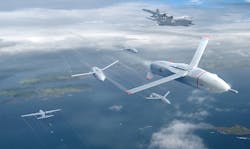DARPA lets research contract for Gremlins program to launch overwhelming drone swarms
Officials of the air Force Research Laboratory at Wright-Patterson Air Force Base, Ohio, announced a $3.9 million contract Wednesday to the Composite Engineering Inc. Unmanned Systems Division in Sacramento Calif., for the first phase of the Gremlins program, which relies on relatively inexpensive unmanned aerial vehicles (UAVs) in volley quantities to saturate enemy defenses.
The Air Force Research Lab awarded the contract on behalf of the U.S. Defense Advanced Research Projects Agency (DARPA) in Arlington, Va. Composite Engineering is part of Kratos Defense & Security Solutions Inc.
Composite Engineering specializes in high-performance aerial target drones, such as the Air Force BQM-167A and U.S. Navy BQM-177A next-generation subsonic aerial target.
The DARPA Gremlins program seeks to launch swarms of small UAVs with C-130 utility aircraft, and then use other C-130 utility aircraft to recover as many of these drones as possible. The Gremlins approach would launch swarms of UAVs equipped with surveillance and electronic warfare (EW) payloads beyond enemy air defenses, and then recover surviving UAVs when they have completed their missions.
Related: Military pursues unmanned swarms of drones working as teams to overwhelm the enemy
Composite Engineering's challenge is to design UAVs that are inexpensive enough so that occasional losses would not compromise the overall mission. These drones should be able to communicate and cooperate with one another, so surviving drones could assume the roles of those unmanned aircraft lost during the mission.
DARPA researchers want Composite Engineering to develop affordable UAVs that could be reused as many as 20 times for dangerous missions in contested air space like pre-attack reconnaissance and surveillance, as well as electronic attack to destroy or disable enemy communications, missile defenses, and battlefield networks.
These drones would be fitted with diverse payloads in volley quantities, and would have the attributes of small vehicle size, reusability, and limited vehicle design life, DARPA officials say.
Key enabling technologies for the Gremlins program include aerial launch and aerial recovery techniques, equipment, and aircraft integration concepts; low-cost, attritable airframe designs; design for limited life; automated waveoff strategy; precision digital flight control and navigation; aerial refueling techniques; efficient small turbine engines; automated fuel tank inerting and engine shutoff; small distributed payload integration; and precision station keeping.
Related: How a robotic octopus could help us control autonomous drone swarms
DARPA is pursuing the Gremlins program in three phases: system and technology design; preliminary design; and prototype flight demonstration.
This first phase of the program is expected to involve several different contractors, and spend about $15.8 million, so there should be other contractors in addition to Composite Engineering.
Ultimately DARPA wants a Gremlins flight demonstration by early 2020 to show the feasibility and potential of air-launched, recoverable unmanned aircraft. Only phase-one contractors will be eligible to participate in the program's second and third phases.
The program seeks to make a fundamental shift in the notion of aerial attack. Instead of using conventional, monolithic systems to conduct missions in denied environments, DARPA wants to use several platforms with coordinated and distributed warfighting functions to saturate adversary defenses.
The idea is to use conventional aircraft hosts to transport and launch a volley of gremlins from stand-off ranges. Researchers want to scale-up the number of UAVs such that a loss of any individual drone is reduced as a result of the collaboration between vehicles.
Not only does the program have the potential to enable enhanced mission effectiveness in contested environments, but it also explores an approach to reduce the cost of operations dramatically.
DARPA officials envision the primary focus of the Gremlins program to be on the technical challenges of aerial launch and recovery of volley quantities of air drones.
For more information contact Composite Engineering online at www.kratosusd.com/about-kusd, or DARPA at www.darpa.mil.
